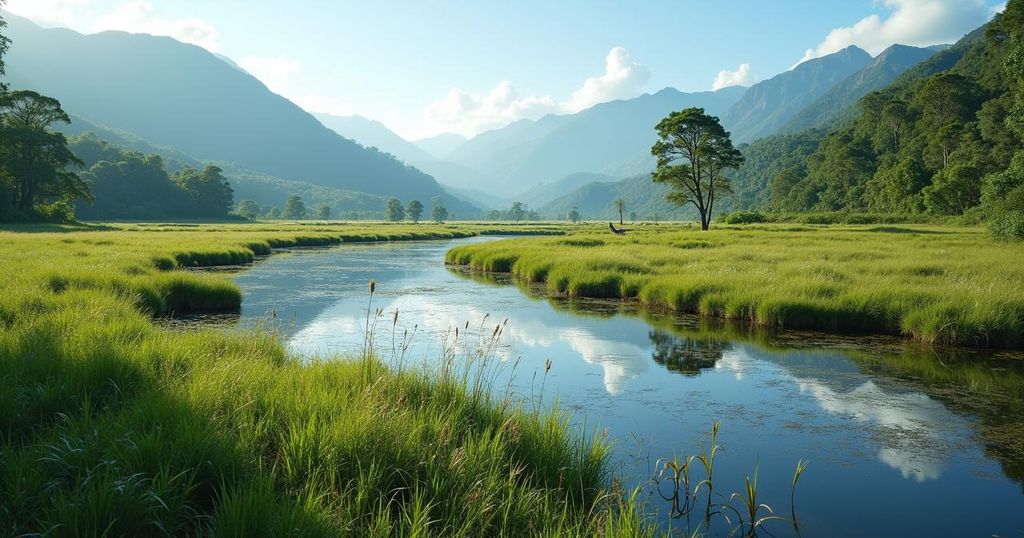Rural communities in Colombia and Ecuador are engaged in efforts to protect high-altitude wetlands, known as paramos, that are vital for water regulation amidst a water crisis caused by droughts linked to El Niño and climate change. Grassroots activism, supported by international organizations, focuses on restoring native vegetation to mitigate these challenges, underscoring the significance of these ecosystems for water security and biodiversity. As Colombia prepares for a biodiversity conference, the restoration projects are critical to ensuring sustainable future water resources for urban populations.
In the Andes regions of Colombia and Ecuador, rural communities are actively engaged in safeguarding fragile high-altitude wetlands, known as paramos, which play a crucial role in regulating the water cycles of these areas. This effort has become increasingly urgent due to severe water and energy rationing that has beset both nations, largely influenced by the ongoing El Niño weather phenomenon, leading to extended drought conditions further exacerbated by climate change and detrimental human activities. The majority of the world’s paramos, key ecosystems that absorb and gradually release rainfall, are situated within the Andes, primarily in Colombia, Ecuador, and Peru. Grassroots activists, supported by international organizations such as Conservation International, are focused on the restoration of native vegetation in an attempt to combat water scarcity and to mitigate the effects of climate change on hydrological dynamics. According to Patricia Bejarano, director of the sustainable high mountain landscapes program at Conservation International’s Colombian branch, “Deforestation in the Amazon, combined with variations that are being caused by climate change and the degradation of the soils is what has caused water dynamics to change.” As Colombia prepares to host the United Nations conference on biodiversity in Cali at the end of October, the significance of protecting the paramos is underscored, elucidating their essential role in tackling climate change, safeguarding water supplies, and ensuring sustainable agriculture. Bogotá, the capital of Colombia with a population nearing ten million, has already begun to experience rotating water rationing due to the prevailing drought, while Ecuador has seen its energy grid strained, resulting in power cuts aimed at conserving water in hydroelectric dams. Consequently, Colombia has temporarily halted electricity exports to Ecuador to bolster its power reserves. In a rural community known as El Tablon, fourteen residents are involved in a nursery initiative within the Paluguillo paramo, where they cultivate Polylepis paper trees, indigenous species that are instrumental in water conservation efforts. Diana Sopalo, a community member, stated, “They’re plants native to the paramo that help us conserve water,” as she emphasized the ecological importance of these trees in capturing and holding water. This community-led nursery, predominantly managed by women, has successfully planted 40,000 trees to date, with plans to increase that number to 100,000. Ms. Sopalo refers to this initiative as “a water factory,” highlighting the role these trees play, especially during dry seasons when they slowly release stored water back into the ecosystem. Paola Fuentes, a water analysis specialist at FONAG, noted that Quito relies heavily on the water derived from the paramos, clarifying, “The water originates in this area and conserving these paramos, these wetlands, is essential for the low areas in the city.” To ensure the protection and monitoring of these regions, FONAG has appointed 26 rangers. Galo Medina, who heads the Nature Conservancy efforts in Ecuador, emphasized the critical nature of these wetland ecosystems, stating, “If the paramos weren’t being managed, we would simply have much less water than we have now.” In Colombia’s Guatavita region, local activists and authorities are formulating plans for the Vista Hermosa de Monquentiva, a protected area within the Chingaza paramo, with intentions to expand this conservation zone. Doris Ramos, an environmental officer for the Guatavita mayor’s office, asserted the importance of safeguarding this park and its unique species, including the frailejones, or espeletia, which are renowned for their capacity to conserve water. She remarked, “While we are restoring this ecosystem, it brings great potential for water, flora and fauna. It is also vulnerable to all the consequences of climate change.”
The context of the ongoing water crisis in Colombia and Ecuador emerges from a combination of climatic phenomena, primarily the El Niño weather pattern, which has caused significant drought conditions in these Andean regions. The populations of both countries heavily rely on hydroelectric power, making them particularly sensitive to fluctuations in water availability. The degradation of natural habitats, such as paramos, due to human activities, including deforestation and land use changes, exacerbates these challenges. The efforts to preserve these ecosystems are critical, not only for local communities but also for broader ecological stability and resilience against climate change.
In conclusion, the efforts of rural communities in Colombia and Ecuador to protect and restore high-altitude wetlands, particularly the paramos, highlight the critical link between environmental conservation and water security. The ongoing water crisis exacerbated by climate change and El Niño emphasizes the urgent need for sustainable practices that preserve these vital ecosystems. The collaborative work of local activists and international organizations showcases the importance of grassroots movements in addressing climate-related challenges and underscores the broader implications for biodiversity and agriculture.
Original Source: www.fastcompany.com






